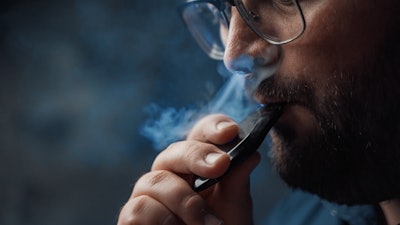
University students commonly use alternative forms of tobacco, particularly e-cigarettes. This habit can cause caries and gingivitis, according to a study recently published in the Journal of the American Dental Association.
Dental professionals should be aware of this trend and the associated oral health risks to effectively address and raise awareness of these issues, the authors wrote.
“Dentists should be familiar with the characteristics of this population and the potential oral repercussions associated with tobacco use to address the impact on health and raise awareness of the associated risks,” wrote the authors, led by Dr. Maria Luiza Hiromi Iwakura Kasai, PhD, of the Universidade Estadual de Londrina Department of Oral Medicine and Pediatric Dentistry in Brazil (J Am Dent Assoc, June 15, 2024).
For this two-phase study, the first part involved administering an online questionnaire to determine the prevalence of tobacco product use among university students. In the second phase, participants underwent physical exams. In total, 620 students responded to the electronic survey, with an average age of 22.5 years.
Of these students, 294 students (47.4%) had used e-cigarettes, 152 (24.5%) had used water pipes, 14 (2.3%) had used chewing tobacco, 148 (23.9%) had used conventional cigarettes, and 266 (42.9%) hadn’t used anything, according to the results.
In the clinical study, 300 participants were evaluated. Among them, 165 students reported using some form of tobacco. Physical exams revealed that 42 patients (14%) had gingivitis; 41 (13.67%) had gingival recession; 35 (11.67%) had clinically visible cavitated caries, with a mean of 2.3 teeth per patient.
In comparison to non-tobacco users, e-cigarette users had a higher proportion of apparent white-spot caries lesions (P value = 0.041) and gingivitis (P = 0.012). Users of both e-cigarettes and water pipes had higher proportions of apparent white-spot caries lesions (16.22% verses 0%; P = 0.014) and gingivitis (21.62% vs 5.93%; P = 0.008).
Users of both e-cigarettes and conventional cigarettes had higher proportions of apparent white-spot caries lesions (17.39% vs 3.70%; P = .027) and caries (30.43% vs 8.89%; P = .009). Finally, users of e-cigarettes, water pipes, and conventional cigarettes had higher proportions of gingivitis (22.22% vs 5.93%; P = .037), according to the results.
However, the study had limitations. Grouping occasional users with regular users may have biased the estimates. Nevertheless, such are essential for identifying early issues related to new substance use in the population, the authors wrote.
“The use of alternative forms of tobacco consumption is common among university students, with e-cigarette use being the most prevalent form, and may lead to detrimental effects on the oral cavity, such as caries and gingivitis, particularly when used in conjunction with other tobacco products,” Kasai and colleagues wrote.




















